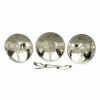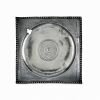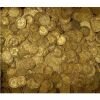
� British Museum
Five Rectangular Plaques in Sheet Gold from the Oxus Treasure.
Rectangular Plaque, Achaemenid Persian (5th-4th Century B.C.)
Takht-i Kuwad, Tadjikistan
Sheet gold
H. 6.05 cm, W. 2.55 cm, Wt. 3.11 g.
ANE 123975
Rectangular Plaque, Achaemenid Persian (5th-4th Century B.C.)
Takht-i Kuwad, Tadjikistan
Sheet gold
H. 13.0 cm, W. 6.0 cm, Wt. 42.83 g
ANE 123974
Rectangular Plaque, Achaemenid Persian (5th-4th Century B.C.)
Takht-i Kuwad, Tadjikistan
Sheet gold
H. 4.85 cm, W. 2.3 cm, W. 2.85 g.
ANE 123976
Rectangular Plaque, Achaemenid Persian (5th-4th Century B.C.)
Takht-i Kuwad, Tadjikistan
Sheet gold
H. 3.85 cm, W. 1.5 cm, Wt. 0.97 g.
ANE 123967
Rectangular Plaque, Achaemenid Persian (5th-4th Century B.C.)
Takht-i Kuwad, Tadjikistan
Sheet gold
H. 5.8 cm, W. 3.55 cm, Wt. 8.42 g.
ANE 123985
Wrought of thin delicate gold, five male figures wearing belted tunics are represented on these diminutive plaques. Many of these warriors hold spears in a formal and upright stance. Their solid erect posture is reminiscent of the high-relief figures on the fa�ade of the
apadana or Audience Hall at Persepolis.








